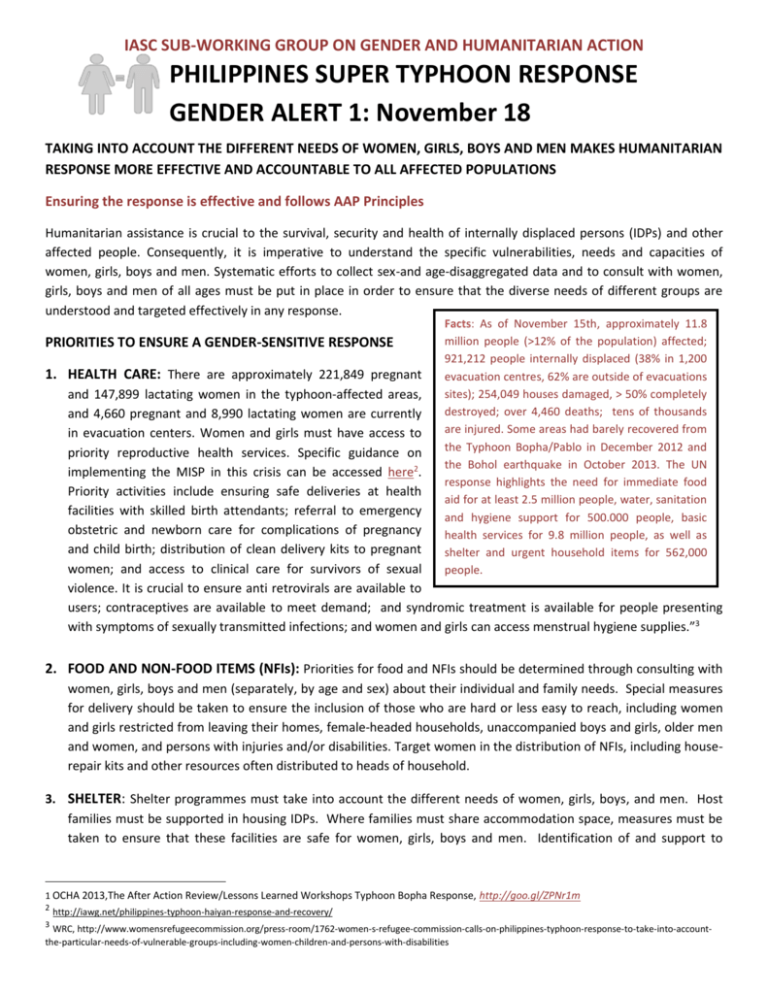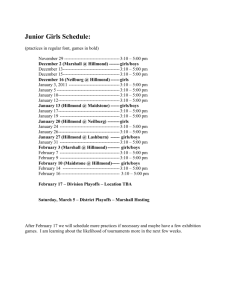
IASC SUB-WORKING GROUP ON GENDER AND HUMANITARIAN ACTION
PHILIPPINES SUPER TYPHOON RESPONSE
GENDER ALERT 1: November 18
TAKING INTO ACCOUNT THE DIFFERENT NEEDS OF WOMEN, GIRLS, BOYS AND MEN MAKES HUMANITARIAN
RESPONSE MORE EFFECTIVE AND ACCOUNTABLE TO ALL AFFECTED POPULATIONS
Ensuring the response is effective and follows AAP Principles
Humanitarian assistance is crucial to the survival, security and health of internally displaced persons (IDPs) and other
affected people. Consequently, it is imperative to understand the specific vulnerabilities, needs and capacities of
women, girls, boys and men. Systematic efforts to collect sex-and age-disaggregated data and to consult with women,
girls, boys and men of all ages must be put in place in order to ensure that the diverse needs of different groups are
understood and targeted effectively in any response.1
PRIORITIES TO ENSURE A GENDER-SENSITIVE RESPONSE
1. HEALTH CARE: There are approximately 221,849 pregnant
Facts: As of November 15th, approximately 11.8
million people (>12% of the population) affected;
921,212 people internally displaced (38% in 1,200
evacuation centres, 62% are outside of evacuations
sites); 254,049 houses damaged, > 50% completely
destroyed; over 4,460 deaths; tens of thousands
are injured. Some areas had barely recovered from
the Typhoon Bopha/Pablo in December 2012 and
the Bohol earthquake in October 2013. The UN
response highlights the need for immediate food
aid for at least 2.5 million people, water, sanitation
and hygiene support for 500.000 people, basic
health services for 9.8 million people, as well as
shelter and urgent household items for 562,000
people.
and 147,899 lactating women in the typhoon-affected areas,
and 4,660 pregnant and 8,990 lactating women are currently
in evacuation centers. Women and girls must have access to
priority reproductive health services. Specific guidance on
implementing the MISP in this crisis can be accessed here2.
Priority activities include ensuring safe deliveries at health
facilities with skilled birth attendants; referral to emergency
obstetric and newborn care for complications of pregnancy
and child birth; distribution of clean delivery kits to pregnant
women; and access to clinical care for survivors of sexual
violence. It is crucial to ensure anti retrovirals are available to
users; contraceptives are available to meet demand; and syndromic treatment is available for people presenting
with symptoms of sexually transmitted infections; and women and girls can access menstrual hygiene supplies.”3
2. FOOD AND NON-FOOD ITEMS (NFIs): Priorities for food and NFIs should be determined through consulting with
women, girls, boys and men (separately, by age and sex) about their individual and family needs. Special measures
for delivery should be taken to ensure the inclusion of those who are hard or less easy to reach, including women
and girls restricted from leaving their homes, female-headed households, unaccompanied boys and girls, older men
and women, and persons with injuries and/or disabilities. Target women in the distribution of NFIs, including houserepair kits and other resources often distributed to heads of household.
3. SHELTER: Shelter programmes must take into account the different needs of women, girls, boys, and men. Host
families must be supported in housing IDPs. Where families must share accommodation space, measures must be
taken to ensure that these facilities are safe for women, girls, boys and men. Identification of and support to
1 OCHA 2013,The After Action Review/Lessons Learned Workshops Typhoon Bopha Response, http://goo.gl/ZPNr1m
2
3
http://iawg.net/philippines-typhoon-haiyan-response-and-recovery/
WRC, http://www.womensrefugeecommission.org/press-room/1762-women-s-refugee-commission-calls-on-philippines-typhoon-response-to-take-into-accountthe-particular-needs-of-vulnerable-groups-including-women-children-and-persons-with-disabilities
IASC SUB-WORKING GROUP ON GENDER AND HUMANITARIAN ACTION
unaccompanied youth, children, older women and men without family members, or those caring for young children,
should be prioritized.
4. WATER, SANITATION AND HYGIENE (WASH): Sanitation and water facilities must be designed and provided
according to the distinct needs of women, girls, boys and men, which can only be identified through consultation
with each gender/age group. Information on WASH practices and the different roles and patterns of different
members of households in terms of access and mobility, consumption, collection and engagement in operations and
maintenance is critical to the safety, health and wellbeing of women, girls, boys and men of all ages.
5. CASH ASSISTANCE: Women and men must benefit equally from cash assistance programmes. Any cash assistance
programme must be built on a gender analysis and be relevant to the local context to determine who will benefit, to
ensure that gender inequalities are not exacerbated, and to avoid harmful consequences such as increased domestic
violence. A tip-sheet on gender dimensions of cash assistance can be found here.4
6. LIVELIHOODS:
Providing economic
opportunities and
Relevant Lessons from Typhoon Bopha Response
preserving existing economic assets as early as possible
Shortcomings:
during response is critical. While Filipina women were in paid
Baseline data was not disaggregated by age and
employment prior to the typhoon, they were, on average,
gender leading to insufficient information on
paid less than men, are more likely to work in small
vulnerable groups (pregnant and lactating
companies or the informal sector and are concentrated in
women, people with disabilities, single-headed
households, and elderly).
lower-paid work.56 A considerable number of Filipinos
7
Lack of representation of beneficiaries in
undertake unpaid work in family businesses
Prior to
coordination meetings decreased impact and
Typhoon Bopha, 10% of children were engaged in child labor,
accountability of the response.
particularly agricultural work. Afterward, adolescent boys
migrated to the city to find jobs and began vulnerable to
Recommendations:
8
violence, abuse, and trafficking. Women and girls are
Institutionalise the collection of disaggregated
data.
particularly vulnerable after disasters, and can be protected
Organise community representation, with equal
from sexual exploitation by engaging in safe, viable economic
gender balance, in the decision making process.
opportunities.”9 Effective livelihood programming is also an
Address the loss of income felt by families
essential component of early recovery. Engaging women in
whose children were engaged in child labor to
decrease adolescents’ risk of exploitation.
livelihood activities is critical and cash-for-work programmes
OCHA 2013 the After Action Review 1
and temporary employment schemes should strive for
gender balance in participation. However, it is equally important to ensure that women are not overburdened with
additional responsibilities. Systematic consultation with both women and men and an analysis of potential obstacles
is therefore essential for successful livelihood activities, and ways to lessen other responsibilities should be sought,
e.g. through provision of child care arrangements.
7. GENDER-BASED VIOLENCE (GBV): “An estimated 49,000 women of reproductive age 15 to 49 years old are at
risk of sexual violence in areas impacted by Typhoon Haiyan.” Prior to the disaster, it was estimated that one in
4http://www.humanitarianresponse.info/system/files/documents/files/Gender%20Tip%20Sheet%20for%20Cash%20Transfers%20Application%20in%20Crisis_%20De
cember%202012.pdf
5
Philippine Commission on Women, 2013, Filipino Women and Men Fact Sheet
6 http://goo.gl/H0wOcF
7 Philippine Commission on Women, 2013, Filipino Women and Men Fact Sheet
8
Protection Cluster Fact Sheet Typhoon Bopha Response As Of 14 January 2013,
9
WRC, http://www.womensrefugeecommission.org/press-room/1762-women-s-refugee-commission-calls-on-philippines-typhoon-response-to-take-into-accountthe-particular-needs-of-vulnerable-groups-including-women-children-and-persons-with-disabilities
IASC SUB-WORKING GROUP ON GENDER AND HUMANITARIAN ACTION
five women between 15 and 49 years of age experienced at least one form of gender based violence.10 “Protection
risks may be exacerbated following a large-scale natural disaster, particularly in situations where security is
compromised and the risk of sexual and gender-based violence is heightened”. 11 Agencies should take immediate
measures to protect women, girls, persons with disabilities and other vulnerable people, such as single women and
unaccompanied children, from sexual violence, abuse and exploitation in evacuation centers and shelters, and when
accessing other basic necessities. Rapid response to sexual violence is critical; treatment within three days of an
assault can prevent HIV infection and within five days can reduce the risk of pregnancy.”12
8. ASSESSMENT AND PLANNING: Needs assessments, such as the upcoming MIRA, project developments and revision
of the Humanitarian Action Plan by UN and partners must prioritize sex-and age-disaggregated data and genderresponsive consultations with women and men. There can be no implementation of AAP without it. For more
details, please refer to the ADAPT an ACT-C Framework for gender programming found in the IASC Gender
Handbook for Humanitarian Action.13. Avoid use of generic words like households, IDPs, vulnerable groups, farmers
etc., which mask important differences between groups and between women and men of different ages within that
group. Being gender-sensitive does NOT mean simply substituting, “women, girls, boys, and men” every time we
see the word “people” but rather, thoughtfully considering whether there are significant distinctions within a group
that need to be addressed.
THREE IMMEDIATE ACTIONS:
A. ASSESS NEEDS. The needs of women, girls, boys and men differ during and after an emergency. Ensure quantitative
data collected in assessments is disaggregated by sex and age. Assessment teams must at least include females, and
ideally be gender-balanced. Take any necessary special measures, such as same-sex interviewers, private, segregated
space, and times convenient to both women and men’s workloads. Consultation with women and men of all ages is
critical to determining their needs, priorities and capacities and then reflecting them in program design.
B.
BE ALERT & ACT TO MITIGATE. Identify the challenges faced by separated women, adolescent boys and girls, older
women and men, and men excluded from work. Put in place measures to ensure their safety and security and to reduce
the risk of violence. In shelters and emergency centers: ensure that women and girls without male companions are
provided with safe spaces separate from unrelated men; that access to latrines is well-lit and close to the camp; that the
distribution of aid is safe for all who are eligible to obtain it; and that the risk of exploitation for internally displaced
persons, in particular, women and children, to have their needs met is minimized.
C. COORDINATE. Coordinate across humanitarian sectors to find meaningful ways to engage women, men, girls, and boys
in the assessment of the needs and the design and management of the programmes for their benefit. Act on their
advice to shape and improve response.
FOR MORE INFORMATION and technical support, please contact the co-chairs of IASC Sub-Working Group on Gender and
Humanitarian Action:
UN WOMEN, David Coffey: david.coffey@unwomen.org
WOMEN’S REFUGEE COMMISSION, Elizabeth Cafferty: elizabethc@wrcommission.org
UNHCR, Larry Bottinick: bottinic@unhcr.org
10
Philippine Commission on Women, 2013, Filipino Women and Men Fact Sheet
Philippines Tyhhoon Haiyan Action Plan Nov 2013
12 WRC, http://www.womensrefugeecommission.org/press-room/1762-women-s-refugee-commission-calls-on-philippines-typhoon-response-to-take-into-accountthe-particular-needs-of-vulnerable-groups-including-women-children-and-persons-with-disabilities
13 http://www.humanitarianresponse.info/themes/gender/resources (accessed 20/06 2012)
11









